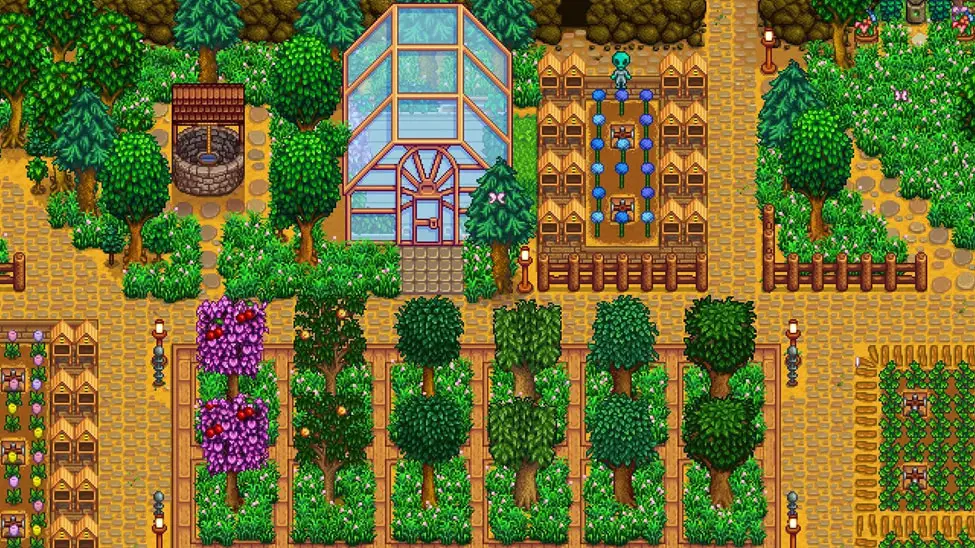Hello, friends! The greenhouse in Stardew Valley is a powerful facility that can be repaired by completing the pantry collection bundle in the community center, or by purchasing it for 35,000g at the JojaMart. The greenhouse allows for year-round planting, ignoring seasonal restrictions, and eliminates the need for scarecrows, tilling, and weeding. This enables continuous cultivation of high-priced summer crops or the planting of multiple harvest crops.

Choosing the Best Crops for Your Greenhouse
First-year Greenhouse Crop Suggestions
If you have just opened your greenhouse in the first year, what should you plant? Assuming the greenhouse is available from mid-fall, you have one and a half months until the end of the year. If you have already started brewing, planting crops for brewing is the best choice. The three most efficient brewing crops are Starfruit, Ancient Fruit, and Hops.
Starfruit and Ancient Fruit Using Deluxe Speed-Gro
Starfruit matures in 9 days, yielding a daily profit of (3150–400)/9 = 305g per tile. Planting 116 tiles for one and a half months generates a theoretical profit of 1.49 million gold. Ancient Fruit, on the other hand, matures in 7 days using Deluxe Speed-Gro, yielding 330g daily profit per tile. Planting a full greenhouse of Ancient Fruit results in a theoretical profit of 1.07 million gold by the end of the first year, with less maintenance than Starfruit.
Hops Hops offer a higher daily profit of 420g per tile
using Deluxe Speed-Gro, maturing in 8 days. Planting 80 Hops alongside Starfruit generates a theoretical profit of 1.96 million gold by the end of the first year. However, this strategy requires more effort.
It’s important to note that the figures mentioned above are theoretical profits, calculated based on average daily income. In practice, the actual profits from Starfruit and Ancient Fruit may differ significantly within the first year due to variations in the timing of the final harvest. So, why is it essential to compare the profits of the first year?
The game has a crucial mechanic where shop item prices increase in the second year. As a result, understanding your potential earnings in the first year can help you make informed decisions about your crop investments and prepare for the price inflation in the upcoming year.
Managing the Greenhouse
Preparing for Year Two
Shop prices for items such as wood, copper ore, iron ore, and coal will increase significantly, making it crucial to earn money in the first year. For example, the cost of crafting a keg increases from 1,750g in the first year to 4,000g in the second year. In the first year, purchasing materials for 400 kegs costs around 700,000g, and you’ll need an additional 100,000g for other materials.
Crop Recommendations For the first year
Starfruit is the top recommendation. Harvesting three times in a month isn’t too troublesome, and it requires fewer kegs.If you find yourself short on funds during the summer, consider prioritizing Hops to boost your income. Hops can be a valuable crop choice to make up for any financial shortcomings, allowing you to maintain steady progress and investment in your farm throughout the year.
. If you acquire Ancient Seeds quickly, prioritize Ancient Fruit. Avoid focusing solely on Ancient Fruit if you lack funds, as it may leave you short of money for materials at the end of the year, leading to a tiresome mining grind.
Non-brewing Alternatives If you don’t plan to pursue brewing and prefer to sell crops directly
Plant Starfruit for an estimated monthly profit of 180,000g. Other options include Pumpkins (approximately 90,000g per month), Blueberries (over 100,000g per month), and Strawberries and Cranberries. In the later stages of the game, when money is no longer an issue, switch to planting vegetables for achievements or recipe ingredients.
Prioritizing Hops for Supplemental Income
If you find yourself short on funds during the summer, consider prioritizing Hops to boost your income. Hops can be a valuable crop choice to make up for any financial shortcomings, allowing you to maintain steady progress and investment in your farm throughout the year.
